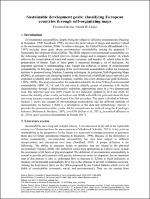Chapter Sustainable development goals: classifying European countries through self-organizing maps
Author(s)
Davino, Cristina
Nicola, D’Alesio
Language
EnglishAbstract
Environmental sustainability is one of the main goals of all countries in the world. Sustainable Development Goals (SDGs) have been proposed by the United Nations in 2015. The purpose of this paper is to explore if and how European countries achievethe goals of environmental sustainability (tracked by the SDGs number 13, 14, and 15). In particular, SDG 13 refers to climate change and its impacts; SDG 14 refers to the conservation of water and marine resources while the last one; SDG 15 deals with the preservation of forests. The reference methodology of the paper are the Self-Organizing Maps proposed by Kohonen in 1982 as an unsupervised clustering method in the framework of artificial neural networks. The proposed analysis considers the 23 indicators related to the three SDGs of environmental sustainability and aims to explore and identify groups of countries with similar characteristics through a dimensionality reduction. Such clusters will be visually represented in a two-dimensional map. The proposed analysis considers the most recent data for all the above SDGs, which is 2018, with the aim of classifying the countries in terms of environmental sustainability and highlighting possible implications for policymakers. An analysis of the network accuracy is shown, using appropriate indicators. These results allow us to see which countries have achieved these goals and how they have deviated from them.
Keywords
Environmental Sustainability; Artificial Neural Networks; Self-Organizing Maps; Sustainable Development GoalsDOI
10.36253/979-12-215-0106-3.17ISBN
9791221501063, 9791221501063Publication date and place
Florence, 2023Series
Proceedings e report, 134Classification
Society and Social Sciences


 Download
Download Web Shop
Web Shop